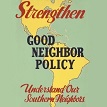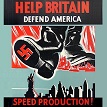 |
1920-1941 |

|
 |
1920-1941 |

|
|
"In the field of world policy I would dedicate this nation to the policy of the Good Neighbor; the neighbor who resolutely respects himself and . . . respects the rights of others; the neighbor who respects his obligations and respects the sanctity of his agreements in and with a world of neighbors."  |
LECTURE GUIDE |
| I. Foreign Affairs during the 1920s A. Opposing viewpoints regarding global involvement 1. Isolation: the predomiant sentiment • disillusionment from World War I • tradition of American isolationism • peace thru isolation while hostile nations war 2. Internat'l cooperation: the minority view • unmet hopes of past U.S. isolation departures • defense dependant upon world leadership • peace thru coop w/ other peace-loving nations 3. Adopted position of "independent internationalism" • traditional unilateralism maintained • gen'l isolationism restored • represented rejection of global responsibility B. League of Nations = 54 members in 1922 1. Prevent war thru disarmament & cooperation 2. U.S. dilemma = isolationism vs. responsibility • membership in League blocked by Senate • "unofficial observers" to sessions of interest • sent official delegates beginning in 1924 • adhered to 13 League agreements by 1932 3. Court of Internat'l Justice aka World Court • planned by Elihu Root; favored by 4 Presidents • Senate thrice keeps U.S. out (1923, '26, '35) C. Naval fleet reductions & construction moratoriums 1. Washington Conference (1921) • Four-Power: w/ Britain, France, Japan • Five-Power: + Italy • Nine-Power: + Belgium, China, N'lands, Portugal 2. Unsuccessful attempts to extend naval holidays • Geneva Conference (1927) • London Conference (1930) D. Kellogg-Briand Pact aka Pact of Paris (1928) 1. Negotiated by 14 nations; supported by 62 2. Condemned war as foreign policy instrument 3. Idealistic; realistically impossible E. Brief global respite during the 1920s ("good news") 1. Dawes Plan (1924) bail-out created circular mess • lowered Germany's debt • provided huge internat'l loan • Weimar Republic prospered ✓ revolutionary factions quieted ✓ intent on fulfilling Versailles Treaty terms 2. Locarno Agreements (1925) • 7 assorted European nations (inc. Germany) • pledged no attack on others & arbitrate issues 3. Germany joined League of Nations in 1926 4. Young Plan (1929) further eased Germany's debt F. Problem of war debts too huge to fix ("bad news") 1. U.S. loaned $10 billion for war & reconstruction 2. Germany defaulted on reparations of $33 billion 3. U.S. extended $ due dates of 17 debtor nations 4. Affair worsened by world economic depression 5. All nations but Finland had defaulted by 1933 G. U.S. tariffs ("protectionism") help fuel the fire 1. Fordney-McCumber Tariff (1922) • raised tariffs to highest level ever • President could adjust up to 50% (37 uses) 2. Hawley-Smoot Tariff (1930) • increased duties additional 20% • 25 nations passed retaliatory measures ✓ injured American foreign trade ✓ many manufacturers moved plants abroad ✓ fostered pre-WWI economic nationalism H. Ultimate failure of U.S. policy (20/20 hindsight) 1. Did not protect American interests 2. Did not promote global stability 3. Did not prevent another world war S. Secretaries of State during 1920s & 1930s 1. 1st student to mention "S" here = some bonus pointses 2. Harding's: Charles Evans Hughes (also Chief Justice) 3. Coolidge's: Frank Kellogg (Kellogg-Briand Pact) 4. Hoover's: Henry Stimson (Stimson Doctrine) 5. FDR's: Cordell Hull (Pearl Harbor duplicity) II. Foreign Affairs during the 1930s A. Independence for Philippines (1933) 1. Initiated under Hoover administration 2. Promised by Jones Act (1916), but delayed 3. Filipinos rejected Hawes-Cutting Act (favoritism to U.S.) 4. Tydings-McDuffie Act (1934) = independence as of 1946 B. FDR formally recognized Soviet Union (1933) 1. Good trade potential (did not develop) 2. Common concern over Japanese aggression C. FDR extended Hoover's "Good Neighbor" policy in Lat. Amer. 1. Hoover: 25 speeches in 10-wk tour of Lat. Amer. (1928) 2. Clark Memorandum (1930) disavowed Roosevelt Corollary 3. Montevideo Pact (1933) reduced U.S. intervention policy 4. Platt Amendment of 1901 cancelled (1934) 5. No more U.S. troops in Haiti, Nicaragua, Dominican Rep. 6. FDR: internat'l trade to lessen effects of Great Depression 7. FDR: hemispheric pals to counter hostile gov'ts elsewhere D. Conferences promoting hemispheric solidarity 1. Rio de Janeiro (1933) denounced wars of aggression 2. Buenos Aires (1936) reaffirmed collective security deals 3. Lima (1938) condemned racial/religious persecution E. Japan increases military aggression 1. Twenty-One Demands (1915) makes China protectorate 2. Stimson Doctrine (1932) denounced Japanese aggressions F. U.S. attempted to promote internat'l revival of trade 1. Trade Agreements Act (1934) allowed FDR 50% tariff flux 2. Sought reciprocal concessions from other nations 3. 1940: treaties w/ 20+ nations, inc. many in Lat. Amer. G. Disclosure of Nye Committee Report (1934-36) 1. Headed by isolationist Senator Gerald P. Nye (No Dak) 2. Vast profits for American "merchants of death" via WWI 3. Many claims exaggerated; some downright inaccurate 4. 1937: 26/100 top companies = contracts w/ German firms 5. 1937: 70% of Americans thought WWI entry was mistake III. Rise of Totalitarian Regimes A. Characteristics of totalitarianism 1. Complete subordination of individual to state 2. Political power (sovereignty) held by single dictator 3. No true separation of powers; therefore checks & balances 4. Marked by lack of civil rights among citizenry 5. Governmental policies enforced by military • military force & police agency = not separate entities • prominent military day-to-day public presence 6. Generally beligerent & imperialistic toward other nations B. Italy: Premier Benito Mussolini (1922) → fascism C. Soviet Union: Premier Joseph Stalin (1924) → communism 1. Resulting from Bolshevik Revolution (1917) 2. Initiated series of Five-Year Plans 3. Eliminated 8-13 μ "enemies of the people" in Great Purge |
D. Germany: Chancellor Adolf Hitler (1933) → nazism 1. Mein Kampf alleged that Germans were "master race" 2. Est'd Third Reich, projected to last 1000 years • First Reich = Roman Empire (800s-1806) • Second Reich = German Empire (1871-1919) E. Spain: General Francisco Franco (1939) → falangism F. Japan: Prime Minister Hideki Tojo (1941) → militarism G. Others: Hungary, Poland, Yugoslavia IV. The Holocaust A. Genocide = deliberate, systematic extermination of group 1. Greek words holo ("whole") + kaustos ("burnt") 2. 6 μ Untermenschen ("subhumans") liquidated under Hitler 3. Mostly Jews; also gypsies, homosexuals, handicapped B. Disintegration of Jewish culture 1. Mein Kampf ("my struggle") • written during 9-mo. jail sentence • declared superiority of German race (aka Aryans) • all other races as German slaves or exterminated • esp. hostile toward Jews, inc. blame for WWI defeat 2. Anti-Semitic program initiated as Hitler took office (1933) • dismissed from public office & civil service • barred from work in journalis, radio, theater • barred from teaching, law, medicine, business • refused service by stores, hotels, restaurants 3. Nuremberg Laws (1935) revoked Jews' political rights • 6+ yrs. old req'd to wear yellow Star of David • Christian X (D'mark) wore Star as "badge of honor" • triangle = gypsies (brown), homosexuals (pink), etc. 4. Kristallnacht ("crystal night") occurs on Nov 9, 1938 • Nazi gangs attacked Jewish homes, synagogues, etc. • Jews blamed for violence & destruction of Kristallnacht C. Many Jews fled from Germany 1. England, France & neutrals Sweden, Switzerland 2. 60,000 to U.S. (inc. Albert Einstein, Paul Tillich, others) 3. 40,000 openings left unfilled due to unemployment D. Endlosung (1939) 1. Extermination plan starting w/ Poland's 2 μ 2. Many grouped & shot by mobile units (Einsatzgruppen) 3. Others herded into city areas to die of starvation, etc. 4. Coordinated by Gen. Heinrich Himmler, head of SS 5. Gens. Julius Streicher & Adolf Eichmann, as well 6. Six death camps built in Poland (1941) • Auschwitz most famous; also Belzec, Treblinka + 3 • "Arbeit macht frei" sign = "work will set you free" • worked to exhaustion, then mercilessly beaten to death • 6,000 gassed daily, then mass buried in pits or burned • gold dental fillings removed, hair shaved to stuff pillows E. Wannsee (Berlin) Conf confirmed Nazi agenda for Jews (1942) F. Jewish plight = global indifference/indecision 1. Allies claimed best way to address was to win war 2. Jewish leaders in U.S. proccupied w/ homeland in Palestine 3. Internat'l Red Cross ignored Polish Jews murder reports G. Additional knowledge & awareness 1. Anne Frank's Diary (originally Het Achterhuis) 2. Schindler's List movie 3. Night by Elie Wiesel 4. Holocaust Memorial Museum (Wash DC) V. Military Aggression Plunges the World into War A. Italy 1. Invaded Ethiopia (1935) 2. Aided (w/ Germany) Franco's uprising in Spain (1936-39) 3. Withdrew from League of Nations (1937) 4. Overran Albania; controlled Adriatic Sea (1939) B. Germany 1. Withdrew from League of Nations (1933) 2. Began military build-up & compulsary service (1934) 3. Aided (w/ Italy) Franco's uprising in Spain (1936-39) 4. Germany terrorized Europe • Rhineland: between France & Belgium (1936) • Austria: proclaimed Anschluss / "union" (1938) • Sudetenland: Lebensraum / "living space" (1938) • rest of Czechoslovakia (1939) 5. Invaded Poland (Sept 1939) • England & France respond by declaring war (WWI !) • little action during winter of 1939-40 (aka "phony war") C. Japan 1. Withdrew from League of Nations (1933) 2. Invaded China (1937) • mass executions & rapes; destruction of property • FDR sends arms & supplies (violation of neutrality) • FDR delivers famous "quarantine" speech • Japan sinks U.S. Panay on China's Yangtze River 3. Tripartite Pact w/ Germany & Italy (1940) D. Russia 1. Annexed Baltic countries & attacks Finland (1939) 2. Withdrew from League of Nations (1939) E. Munich Pact (1938) 1. Acquiescence of France & Britain surprised even Hitler 2. Chamberlain: Pact guaranteed "peace in our time" 3. Policy of "appeasement" inherently unworkable F. Military alliances 1. Pact of Steel (May 1939) • Germany & Italy • Mussolini: "axis around which Europe will revolve" 2. Treaty of Non-Aggression (Aug 1939) • Germany & Soviet Union • broken by German invasion of Russia (June 1941) 3. Tripartite Pact (Sept 1940) • Germany, Italy, Japan • soon later Bulgaria, Hungary, Romania, 3 more G. What's going on? (pre-WWI déjà vu) 1. Aggressive nationalism 2. Imperialism (inc. some "have-not" countries) 3. Rise of totalitarian regimes dedicated to militarism 4. Creation of military alliances 5. International anarchy 6. Lack of effective collective security system 7. Policy of appeasement (by some Western democracies) VI. American Attempts to Avoid War A. Neutrality Acts (1936-39) 1. Designed to nullify circumstances forcing U.S. into WWI 2. Opposed by FDR • compromised American claims to freedom of seas • actually benefited aggressor nations • favored collective security 3. Prohibited sale of war implements to belligerents 4. Barred loans to warring nations 5. Forbade American travel on ships of belligerents 6. All indirect war materials be strictly "cash & carry" basis B. Efforts to bolster hemispheric solidarity (1939-40) 1. Dec. of Panama → huge "safety belt" around Americas 2. Act of Havana → no European colony transfer in America 3. Joint Board of Defense w/ Canada → coordinate efforts |